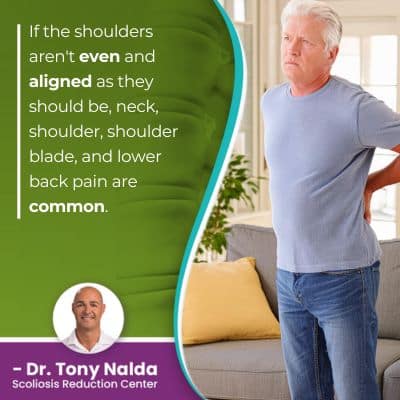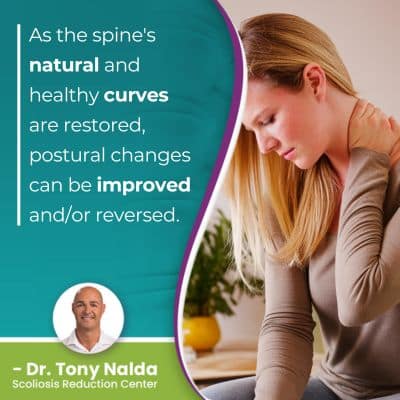How to Correct Uneven Shoulders Caused by Scoliosis

Scoliosis can cause a number of effects felt throughout the body, and not just in and around the spine. Scoliosis introduces uneven forces to the body, and uneven shoulders and hips are often the earliest signs, particularly in children.
In order to improve, reverse, or correct postural imbalances caused by scoliosis, proactive corrective treatment needs to be applied, and while there are no treatment guarantees, the sooner treatment is started, the better. Addressing the condition's underlying structural nature is key.
When it comes to scoliosis treatment, there are different options that produce different results; patients need to be informed.
Table of Contents
Scoliosis and Uneven Shoulders
Scoliosis causes an unnatural sideways-bending and twisting curvature of the spine to develop, and as a progressive condition, its nature is to get worse over time.
As the condition progresses, the spine is becoming more unnaturally bent and twisted, and this makes the spine more rigid, and the progression occurs, the more severe scoliosis becomes, and the more noticeable its effects are.
When the spine's natural curves are in place, the vertebrae are stacked on top of one another in a straight and neutral alignment, as they should be, but when an unnatural spinal curve develops, certain vertebral bodies have become unnaturally tilted, shifting their position out of alignment with the rest of the spine.
When the spine is aligned, the shoulders are even on each side and forward facing, but when the spine becomes misaligned, one shoulder can sit higher than the other and one shoulder blade will protrude more on one side.
Uneven Shoulders and Shoulder Pain
 If the shoulders aren't even and aligned as they should be, neck, shoulder, shoulder blade, and lower back pain are common.
If the shoulders aren't even and aligned as they should be, neck, shoulder, shoulder blade, and lower back pain are common.
When it comes to scoliosis pain, this is more commonly felt by adults as scoliosis doesn't become a compressive condition until skeletal maturity has been reached, but postural changes can cause muscle pain in children.
With an uneven shoulder height, excessive tightness and soreness, along with a pulling sensation, can be felt in the shoulder that's sitting higher.
A scoliotic shoulder imbalance can also cause a rounded-forward appearance of the upper back and shoulders.
There are three main spinal sections, and scoliosis can develop in any one section or in more than one as a combined scoliosis: the cervical spine (neck), the thoracic spine (middle/upper back), and the lumbar spine (lower back).
Uneven shoulders and shoulder pain is most common with unnatural upper back curvatures as the muscles of the thoracic spine are working harder to support the unnaturally-bent spine.
Childhood Scoliosis
Although scoliosis affects all ages, it's more commonly diagnosed in children, and the most prevalent condition type overall is adolescent idiopathic scoliosis, diagnosed between the ages of 10 and 18.
The main effect of scoliosis in children isn't pain, it's postural asymmetry caused by the condition's uneven forces disrupting the body's overall symmetry.
In many cases of childhood scoliosis, the earliest signs of scoliosis are uneven shoulders and hips, and additional postural changes can include:
- The head uncentered over the torso
- An uneven eye line
- Uneven shoulder blades
- An uneven waist line
- The development of a rib cage arch
- Arms and legs that appear to hang at different lengths
As the body's center of gravity shifts, changes to movement are also common, and remember, if left untreated, these changes will get more severe and noticeable over time.
So how do you fix uneven shoulders and the postural changes scoliosis can cause?
Scoliosis Treatment Options
There are two main approaches to scoliosis treatment: surgical and nonsurgical.
When it comes to addressing postural changes, such as uneven shoulders, they are symptoms of the condition, and as symptoms, their underlying cause needs to be addressed, which is the structural changes occurring in the spine; as the vertebrae at the curve's apex become more unnaturally tilted over time, postural changes also become more overt.
When it comes to traditional scoliosis treatment, we're talking about a watch-and-wait approach followed by spinal fusion surgery.
Considering the trigger for scoliosis progression is growth, childhood scoliosis should always be taken seriously because with growth spurts, comes progression and increasing postural problems.
So how a diagnosis of scoliosis is responded to with treatment will shape the spine's long-term health and function.
Traditional scoliosis treatment does little while scoliosis is mild; it doesn't have a strategy for addressing small curves so commonly recommends watching and waiting for continued progression, and severe cases are commonly recommended for spinal fusion surgery.
Surgery and Uneven Shoulders
Spinal fusion involves removing intervertebral discs sitting between adjacent vertebrae to be fused and fusing the curve's most-tilted vertebrae into one solid bone.
Metal rods are then commonly attached to the spine to hold it in place, and hardware attached is permanent, and this approach is associated with a loss of spinal flexibility and range of motion that many patients are disappointed with.
Many patients are also disappointed with the cosmetic results of spinal fusion surgery; spinal fusion addresses the spine, but only the spine; it's not an approach that's known to improve all of the condition's effects, such as uneven shoulders and hips.
So while spinal fusion can address the unnaturally bent spine by straightening it and holding it in place, it's not actually correcting the scoliosis, but is more about stopping the condition from getting worse; conservative treatment, however, offers a nonsurgical treatment alternative that's known to address all of the condition's effects, including postural changes.
Conservative Treatment and Uneven Shoulders
Here at the Scoliosis Reduction Center, my patients benefit from a proactive conservative treatment approach that's chiropractic-centered.
Conservative treatment has the goal of correcting scoliosis; it doesn't just want to stop it from getting worse, but to actually correct it for long-term sustainable treatment results.
As a progressive condition, scoliosis is incurable, so treatment is more about how best to manage an ongoing condition for the best quality of life.
Scoliosis can, however, be highly treatable, and when treatment is proactive and started while conditions are at their mildest and most treatable, many of the condition's effects can be improved and/or reversed.
Chiropractic care and Uneven Shoulders
 The underlying nature of scoliosis is structural, so treatment needs to impact it, first and foremost, on a structural level, and this is worked towards through chiropractic care that can involve a number of techniques and manual adjustments.
The underlying nature of scoliosis is structural, so treatment needs to impact it, first and foremost, on a structural level, and this is worked towards through chiropractic care that can involve a number of techniques and manual adjustments.
Condition-specific chiropractic care can work towards realigning the spine by adjusting the position of the curve's most-tilted vertebrae, and as this is the underlying cause of postural changes like uneven shoulders, the condition's effects are also improved.
As the spine's natural and healthy curves are restored, postural changes can be improved and/or reversed.
Physical Therapy
Condition-specific physical therapy is applied to get the spine and its surrounding muscles ready for treatment, to increase core muscle strength so the spine is optimally supported/stabilized, and address any related muscle tension and imbalance.
Muscle imbalances are a common effect of scoliosis as the unnatural spinal curve pulls them in different directions, and muscles on one side of the spine can become weak from underuse, while muscles on the opposite side become sore and tight from overuse.
Physical therapy is part of a conservative treatment approach because conservative treatment doesn't just treat the spine, but also condition effects as their underlying cause is being addressed.
Corrective Bracing
Corrective bracing is particularly effective on growing spines so is a common facet of treatment for childhood scoliosis, and as the goal of treatment is to achieve a significant curvature reduction and hold it there despite the constant trigger of growth.
Corrective bracing can augment corrective treatment results by pushing the spine into a corrective position.
Rehabilitation
Rehabilitating the spine fully is important, and this can include continued chiropractic care and scoliosis exercises that can be performed from home; this can help further heal and stabilize the spine for long-term sustainable treatment results.
Conclusion
When it comes to fixing the effects of scoliosis, the best approach is addressing their underlying cause: the condition itself.
Postural changes such as uneven shoulders and hips are symptoms of the condition's uneven forces disrupting the body's overall symmetry, and as a progressive condition, the nature of scoliosis is to get worse over time.
Bad posture is a sign of scoliosis, and chiropractic care can help by addressing the structural abnormality within the spine itself, and physical therapy and a variety of scoliosis specific exercises can help by addressing how scoliosis affects the spine's surrounding muscles.
Corrective bracing and rehabilitation are additional facets of treatment, and as the underlying cause of postural changes, the scoliosis itself, is addressed, asymmetries such as uneven shoulders can be addressed; as the spine's alignment is improved, the body's center of gravity shifts back to where it should be, and an even shoulder level can also be restored.
Regardless of condition type or severity, as a progressive condition, the best time to start treatment is always now; early detection and intervention is the best chance of reversing and minimizing uneven shoulders caused by scoliosis.
Dr. Tony Nalda
DOCTOR OF CHIROPRACTIC
After receiving an undergraduate degree in psychology and his Doctorate of Chiropractic from Life University, Dr. Nalda settled in Celebration, Florida and proceeded to build one of Central Florida’s most successful chiropractic clinics.
His experience with patients suffering from scoliosis, and the confusion and frustration they faced, led him to seek a specialty in scoliosis care. In 2006 he completed his Intensive Care Certification from CLEAR Institute, a leading scoliosis educational and certification center.
About Dr. Tony Nalda
 Ready to explore scoliosis treatment? Contact Us Now
Ready to explore scoliosis treatment? Contact Us Now





